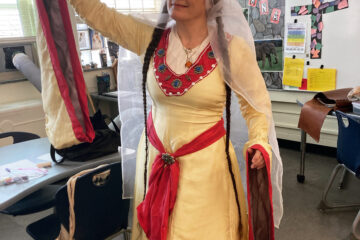The early female writers of science fiction are at last garnering the attention they deserve, which begs the question: if women have been writing genre fiction since its birth, why is it so often thought of as a male dominated, or even exclusively male, genre? What happened?
Great essays have been written on the ability of audiences to forget women, or to tokenize them, however I yearn for a statistical approach. Have the number of women visibly writing in genre changed over time, and if so, how?
I was recently given a chance to admire the Science Fiction Special Collection at Case Western Reserve University and the first magazine I pulled from the shelves had a woman’s name on the cover. Not one I recognized. Sophie or Mary something. I’d been told that many early female writers of science fiction wrote under their initials, like the great C. L. Moore or D. C. Fontana. That would explain their obscurity as women, but here was Sophie-Mary-Something. How many women writing under unambiguously female names were simply forgotten?
It seemed easy, at first: I could go through the Kelvin Smith Library Science Fiction Special Collection and copy down all the tables of contents, counting the male and female names. I started with Amazing Stories, since it is the First Science Fiction Magazine, starting in 1926.
Easy! The authors in that first issue, in April, 1926 were:
| Jules Verne |
| H. G. Wells |
| G. Peyton Wertenbaker |
| George Allen England |
| Austin Hall |
| Edgar Allen Poe |
Immediately, I had to ask myself, “wait, what about initials? Is Jules a traditionally male name or do I just think of it that way?”
The third issue of Amazing Stories has one Jacque Morgan. Is that a woman or a man? How would the name look at that time?
At first, I gave up on determining the gender count and just got to work recording all the tables of contents. I now have a spreadsheet with every table of contents from every issue of Amazing, Astounding/Analog, F&SF, Asmiov’s, Omni, Fantastic, Unknown, Galaxy and Weird Tales — up to 2010. I decided to stop before any of my own work appeared in print, and 2010 felt like a nice round year to pick.
I considered using a service called genderize.io — I could easily split the first names from the last names in my spreadsheet and send them through genderize.io to get back an M or an F. I sent a test batch of ten names through, picking names from the first year of Amazing I had trouble identifying as male or female: Sewell, Sterner, Nat, Francis, Miles, Charlton, Ainslee
Sewell, Nat, Francis, and Ainslee came back female. I knew these were all male writers. Then I realized: Genderize.io is based on predicting MODERN gender… it’s not looking to see what someone in 1926 would consider male-sounding.
I found a free website: http://www.babynameshub.com/gendercompare.cfm
This at least gave me a chart, showing male and female popularity of names over time, and Nat and Francis became solidly male. Ainslee and Sewell still weren’t so sure.
I realized I was never going to get anywhere without marking some names as “neutral.”
So that’s what I did. I marked names that did not come up male or female, or came up both, as “N”. I marked names that had initials as “I”. I created a second column to record the “Known gender” if I could quickly locate a bio using pronouns via ISFDB.
As of today, I have finished assigning an M, F, I, or N to every name. Some things have really surprised me. “Ardath” is historically an unambiguously female name, though I would have thought it was neutral. “Marion” had a greater and longer popularity as a boy’s name than I imagined.
And there were oh so many more women I’d never heard of who had one or two stories published and never appeared again. These are the names I most want counted.
Filling in the “known gender” column felt easy for names like H. P. Lovecraft, but for other authors, especially more recent ones, it felt an unnecessary invasion of privacy. So if I couldn’t find an unambiguous pronoun in two clicks, I marked “known gender” with N, as well. I’m not sure this column is going to be useful, but I’d like to generate statistics on, say, the number of men writing under initials vs. women and if that changed over time.
Next up is using my limited Excel-fu to generate graphs and see what they tell me! Wish me luck!

